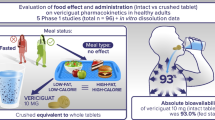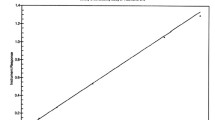Abstract
Purpose. To determine if large differences in the in vitro dissolution profiles for primidone tablets would result in significant bioavailability differences.
Methods. Two separate bioavailability studies were conducted. The first study used 18 healthy subjects and compared the bioavailability of an old 50 mg tablet formulation, a new 50 mg tablet formulation, and a suspension containing 50 mg/ml of primidone. The second study enrolled 24 subjects who were to receive a new 250 mg tablet formulation, two lots of an old 250 mg tablet formulation and a 250 mg tablet from a second manufacturer. In vitro dissolution was conducted over 90 minutes, using USP 23 Apparatus 2 at 50 rpm, with 900 ml of water.
Results. Dissolution at 90 minutes for the old and new 50 mg tablets was approximately 20% and 100%, respectively. The dissolution of the four 250 mg tablets ranged from approximately 30% to 100%. The 50 mg tablet that dissolved slower had a longer Tmax and a 14% lower Cmax than the more rapidly dissolving tablet, but the AUC(0−∞) values differed by only 3%. Only nine subjects completed the 250 mg study because of side effects. The differences in Cmax and AUC(0−∞) among the four 250 mg tablets were less than 7%.
Conclusions. Even though there were large differences in the in vitro dissolution of the 50 mg and the 250 mg primidone tablets, the two 50 mg tablets were shown to be bioequivalent, as were the four 250 mg tablets.
Similar content being viewed by others
REFERENCES
G. L. Amidon, J. R. Robinson, and R. L. Williams (eds). Scientific Foundations for Regulating Drug Product Quality, AAPS Press, Virginia, 1997.
United States Pharmacopeia. Rockville, MD: United States Pharmacopeia Convention, Inc. 1985, p. 878.
United States Pharmacopeia. Rockville, MD: United States Pharmacopeia Convention, Inc. 1990, p. 1141.
M. Gibaldi and D. Perrier. Pharmacokinetics, Marcel Dekker, New York, 1975, pp. 150, 293.
D. J. Schuirmann, A comparison of the two one-sided tests procedure and the power approach for assessing the equivalence of average bioavailability. J. Pharmacokin. Biopharm. 15:657–680 (1987).
L. Z. Benet and R. L. Williams. Appendix II. Design and optimization of dosage regimens: Pharmacokinetic data. In A. G. Goodman, T. W. Rall, A. S. Nies, and P. Taylor (eds.) The Pharmacological Basis of Therapeutics, Pergamon Press, New York, 1990, p. 1699.
The Merck Index, Merck & Co., Inc. New Jersey, 1996, p. 1130.
Author information
Authors and Affiliations
Rights and permissions
About this article
Cite this article
Meyer, M.C., Straughn, A.B., Mhatre, R.M. et al. Lack of In Vivo/In Vitro Correlations for 50 mg and 250 mg Primidone Tablets. Pharm Res 15, 1085–1089 (1998). https://doi.org/10.1023/A:1011942530288
Issue Date:
DOI: https://doi.org/10.1023/A:1011942530288




